[Chapter 4] Changing Needs & A Return to Roots
- Home
- 40th Anniversary Model
- History
- Chronology
- Product Lineup
- News
- Artist Comments
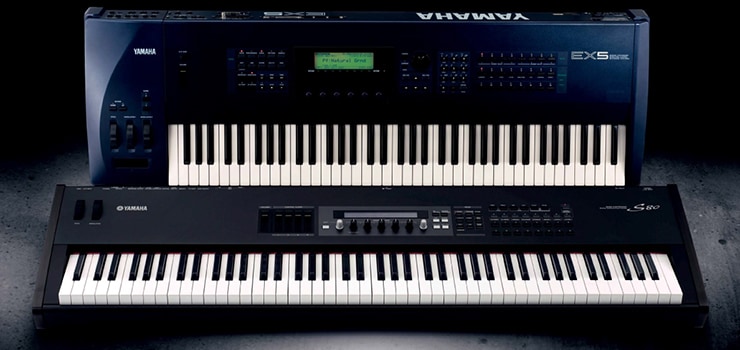
The EX5 workstation synthesizer was released in 1998. The successor to the SY99, this flagship model is truly representative of the synths of the 90s, and was aimed at professional musicians. The S80 music synthesizer was released in 1999, and featured a piano-size 88-key keyboard that clearly differentiated it from other Yamaha synths of the day, This feature, so important to keyboard players, was extremely well received, and also affected the designed of the MOTIF synths that followed it.
[Chapter 4] Changing Needs & A Return to Roots
Intuitive sound creation
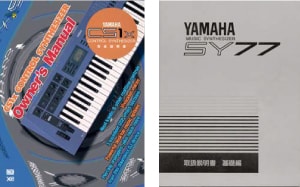
User's manuals for the CS1x and SY77. Even the covers show the difference between the two manuals.
In the first half of the nineties, Yamaha introduced a wide range of new synth models, leveraging formidable technical expertise acquired in the development of the workstation-type synth and the new VA tone generation system. In contrast to the eighties, however, our synthesizer business was in difficulties, and we failed to score any successes of the same level as the DX7. This was caused in part by changes in the synth market. In the past, users had been drawn to innovative technologies and models, and new products practically flew off the shelves. By the nineties, however, continuous advances in semiconductors, programming, and other related fields meant that regular users were no longer excited by technology alone. As a result, manufacturers turned their attention to design, user interfaces, product concepts, and marketing. This period was also notable for significant changes in the music scene and the ways in which synths were typically used. All in all, the industry was in an extremely chaotic state.
A new trend thus emerged in the synth industry—the return of the analog synth. This does not mean that the analog synthesizers of the seventies were simply put back into stores; instead, products that featured sounds and utilized sound-creation techniques similar to those of the analog synth and known as "virtual analog synthesizers" started to grow in popularity. In other words, users were looking for instruments that could simulate those classic analog synths using the latest digital technologies.
A number of factors contributed to this increasing popularity of the virtual analog synthesizer, but one of the most crucial was an inability to create sounds in an intuitive fashion using the digital synths of the day. Instruments like the DX7 had as few switches, dials, and other controllers as possible, leaving the musician to navigate through menu after menu in order to make changes to a bewildering array of sound parameters. PC-based editor software had been developed, and this allowed sounds to be sculpted using a graphical interface, but the approach was far from ideal for live performance, where tone, timbre, and other sound characteristics needed to be instantly controllable. Once the digital filters developed in the nineties had become fully accepted, sound designers started going back to their easy-to-understand cutoff and resonance parameters, which were responsible for creating the unique squidgy sound of the analog synth. And when the attack, decay, sustain, and release parameters of the envelope were also added to the mix, even more emphasis was placed on the ability to directly manipulate parameters in the same way as on the synths of the seventies. Parallel to this, in the world of dance music DJs started to thrill audiences by performing in real time using filters built into mixers that were designed for their own specific needs, further intensifying demand for powerful filter-based sounds with cutoff and resonance at their core.
Recognizing this need, we introduced the CS1x Control Synthesizer in 1996. A compact, lightweight instrument coming in a fresh blue color, it featured a rotary switch for rapid selection of editable parameters as well as a host of other innovative features never before seen on Yamaha synths. Many of these were perfectly suited to the sound-creation needs of the day—a perfect example being dedicated sound control knobs for instant manipulation of key parameters such as cutoff and resonance. What's more, this instrument was one of the first with a built-in arpeggiator, allowing the owner to create intricate musical phrases by simply holding down a chord on the keyboard. Prior to this, the synthesizer had commonly been perceived as a keyboard player's instrument—something that could only be played by skilled pianists. This arpeggiator, however, made it possible for practically anyone to perform on the synth. The CS1x was also notable for the way in which the arpeggiator and sound control knobs could be used together for exciting, creative performances that required no advanced keyboardist skill.

CS1x
A full-fledged virtual analog synthesizer
The CS1x and other similar synths won over many customers by making sound creation easy to understand once again and providing for real-time manipulation. Meanwhile, the sound of the analog synth was becoming more and more critical to techno and other forms of electronic dance music. As a result of these factors, demand grew for digital synths that could produce analog-like sounds. A wide range of analog modeling synths were also released by other instrument manufacturers, and software synthesizers employing the analog modeling approach also started to appear.
In 1997, one year after releasing the CS1x, Yamaha followed up with the AN1x, a digital model optimized for use as an analog synth. This was made possible by analog physical modeling, a new technology that simulated even the subtle yet unique characteristics of waveforms produced by analog-synth oscillators and the way in which slight instabilities in their electrical systems affect the sound. Despite its digital design, this full-fledged virtual analog synthesizer could easily hold its own with other instruments in a band and was extremely well received. Meanwhile, in order to make the CS1x more suited to live performance, we increased the number of sound control knobs to eight from the six on the CS1x and added a ribbon controller.
The extremely popular music-production synths of the mid-nineties all had common sound banks thanks to the widespread adoption of GM*1, XG, and other similar technologies. This meant that they could reproduce the sounds of acoustic instruments such as drums and piano, and most could be used to produce full arrangements without the need for any other devices. In contrast, the Yamaha developers took the bold step of intentionally omitting support for this feature from the CS1x in order to perfect it as a simple performance synthesizer.
- *1: The General MIDI (GM) standard was developed in order to ensure compatibility between the sounds produced by different synthesizers. Instruments complying with this standard have a set of 128 specific sounds, such as piano and guitar, in addition to all of the voices for one complete drum set. As such, any GM tone generator can play back MIDI-format song data created using a synth from a different manufacturer and still sound correct.
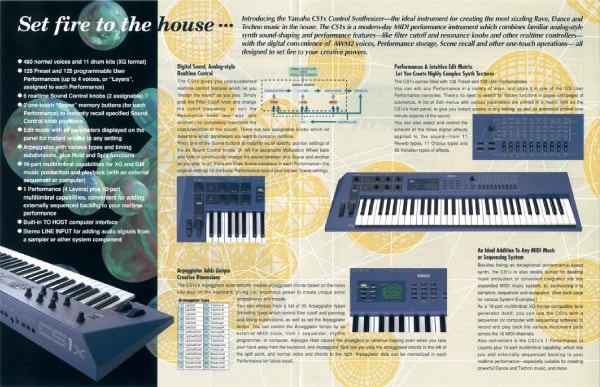
CS1x catalog (English-language edition)
Enhancing product development with feedback from market research

AN1x
Thanks to the growing popularity of the Internet towards the end of the nineties, synthesizer owners could instantly access information from all over the world, and modes of use of the synth began to diversify rapidly. In our industry, it thus became extremely important to ascertain the needs and behavior of synth users through market research and develop the right products in response. While this certainly included improvements to tone generation systems, keyboards, and other hardware, serious attention also had to be paid to the physical design and color of synths, how they were actually put to use after purchase, and a wide range of other factors. Meanwhile, there was growing demand for synths and all of their unique features and functions to be easier to understand, even for beginners. From this perspective, the changes occurring in the synth industry during this time are most apparent in their owner's manuals. Even just looking at their covers, these booklets had clearly become much more contemporary and modern than in the era of the SY Series.
With the beginning of the latter half of the nineties, we started to feed back all of the findings of our prior research to product development. Introduced in 1998, the EX5 flagship workstation synthesizer encapsulated all of our effort during that decade.
Following the release of the SY Series, Yamaha rearranged its synth lineup to focus on (with the exception of the VL1 and VP1) low-end models with good cost performance in order to appeal to a new set of customers. As such, we introduced no professional-level synthesizer worthy of being called a successor to the SY99 during that period, something that changed with the arrival of the EX5.
The sound engine of this music synthesizer featured an AWM2 tone generator, the first from Yamaha's to deliver 128-note polyphony; a VA physical modeling tone generator as developed for the VL1; the popular AN virtual analog tone generator from the AN1x; a Formulated Digital Sound Processing (FDSP) tone generator that had been newly developed to allow DSP control using pitch and other individual items of note data; and a flexible, integrated sampling system. This veritable powerhouse of synthesis incorporated practically all of the technologies we had perfected to date—in particular, controllability was enhanced to the maximum with, for example, a three-wheel design combining a pitch bend wheel with two modulation wheels and a ribbon controller. Yet the improvements realized for the EX5 extended beyond pure function, and the sound of the instrument similarly reflected our research findings. It could also produce the thick synth sounds that had been highly praised upon the release of the AN1x, allowing the EX5 to deliver unique sounds with a richness never heard before.
Simultaneous development of new tone generation systems
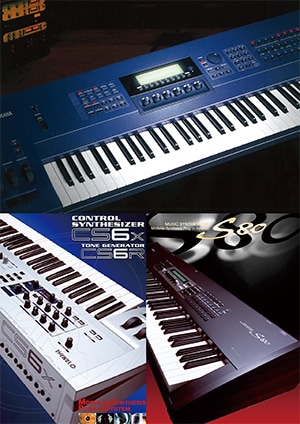
Top: EX5 (From the English-language catalog
Bottom left: The CS6x Bottom right: S80
(Both from the Japanese catalogs)
After introducing physical modeling tone generators in the VL1 and the VP1, Yamaha also worked on the parallel development of a number of new tone generators, such as the AN virtual analog tone generator of the AN1x and the FDSP tone generator found on the EX5. One of the more notable achievements of this effort was the revolutionary Formant Synthesis (FS) tone generator. The FDSP and FS engines both represented further advances of existing tone generation technologies, but the FM-based FS tone generator in particular made headlines with an innovative approach that produced sound by adding together formants—that is, tones characteristic of the human voice. Its implementation in the FS1R was driven by an eight-operator FM tone generator, and thanks to features such as backwards compatibility with DX7 voices, it soon developed a reputation as a hidden treasure.
The FS tone generator uses formant elements as voice parameters, and as you might expect, this allows it to produce sounds similar to those of the human voice. At the time of its release, Yamaha was already marketing a plug-in board called the PLG100-SG as a sound module expansion for desktop music (DTM). This caused quite a stir in the Japanese market back then with its ability to sing lyrics entered in Japanese. Although today's Vocaloid products also sing lyrics, this synth did so much earlier, using a totally different design. This is further evidence of the artisan spirit of Yamaha developers—never neglecting technical innovation, even in the face of difficult operating conditions that demanded the market be put above all else.
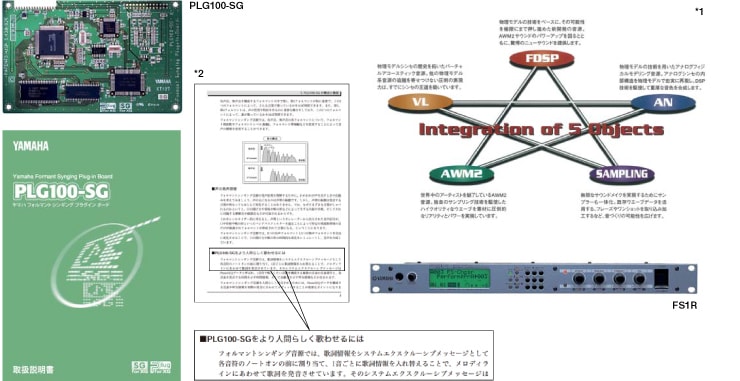
*1: From the Japanese version of the EX5 catalog.
*2: The PLG100-SG user's manual
The Japanese version of the user's manual shows how to make the instrument" sing like a real human being."
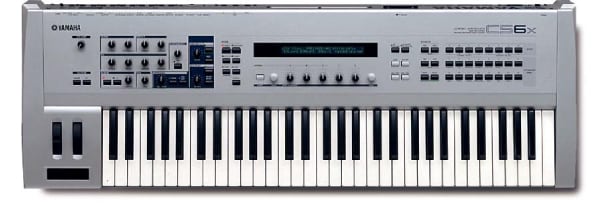
CS6x
The results of market research
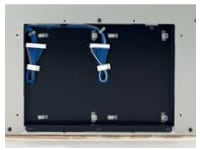
Expansion slots at the rear of the CS6X
Following on from the SY Series, Yamaha released a great many products that combined a variety of technologies in an effort to offer functions ideal for the needs of the day. However, absent of any massive hit like the DX7, the nineties was a difficult time for our synthesizer business. Light at the end of the tunnel finally came in the shape of two models released at the same time in 1999—namely, the CS6x and the S80.
One might well assume based on its model name that the CS6x comes from the same family as the CS1x Control Synthesizer, but it was actually developed primarily as an instrument for serious on-stage use. The most immediately noticeable difference is the new color scheme. In contrast to the refined black and dark-blue bodies that had been the norm until then, the CS6x was silver. We had, of course, released brightly colored products prior to the CS6x, but they had mostly been limited editions or special silver versions with an "S" added to the model name: this was the first time that a Yamaha synth had been released solely in silver.
This synthesizer mainly produced PCM sounds using its built-in AWM2 tone generator; however, it could also be expanded using up to two additional plug-in tone generator boards that provided owners with access to VL, AN, FM, and other sound engines. In order to appeal to the club scene, we asked famous European sound creators to design its preset voices. As such, the CS6x fully satisfied the needs of the market in terms of both hardware and software. Thanks to fat sounds inherited from the EX5, a cutting-edge plug-in system, its simple sound-engine design, and coloring that made it stand out on stage, this synth became very popular, particularly in Europe.
Whereas the CS6x was developed with an eye to the European market, Yamaha incorporated a great deal of feedback from North America into the S80. For instance, the quality of piano sounds—a must for the serious keyboardist—was significantly improved, and with 88 keys this synth's keyboard was just as long as a real piano's. These and other novel features marked a fresh departure from the Yamaha synthesizers that had come before.
As a further means of ensuring that all of the principal needs of players would be satisfied, we selected our AE*2 design for the keyboard because it had the same feel and touch as a real piano while also being perfectly suited to playing synth and organ sounds. In the music scene of the day, synths were most commonly used for piano voices in a band or as part of a jazz session, although keyboardists also made frequent use of organ, strings, and other similar voices. As such, the features of the S80 were perfectly suited to these market needs, and it made steady in-roads, particularly among professional musicians.
It is generally accepted that all basic synths (with the exception of portable models) will have their pitch bend and modulation wheels to the left of the keyboard. On the S80, however, they were moved to the top left of the front panel. Making it possible to reduce the overall instrument length needed to house the 88-note keyboard, a modification that took into consideration the fact that many keyboardists in North America at the time moved their synths around in the trunks of cars, so making the length of the instrument an important factor. We would not have been able to satisfy this need had it not been for research in the North American market.
The CS6x and the S80 had an enormous impact on how Yamaha would go on to develop synthesizers in the following decade—the first of the 21st century. For example, the silver design of the CS6x had a major effect on color selection for the soon-to-be-released MOTIF Series, and the success of the S80 as a viable alternative to real pianos influenced our decision to configure the synth product lineup with the MOTIF8 having a piano-like feel while the MOTIF6 and MOTIF7 had a synth action. While it cannot be denied that Yamaha synths struggled through the nineties, the completely new approaches adopted for the CS6x and the S80 revealed the right path to take in the years ahead.
- *2: The AE keyboard is highly expressive yet supple, making it ideal for playing both piano and synth sounds, as well as for rock piano performances. Also supporting aftertouch, it is perfectly suited to use as a master keyboard.
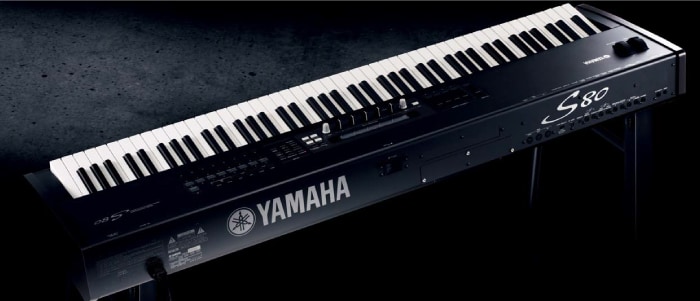
S80





